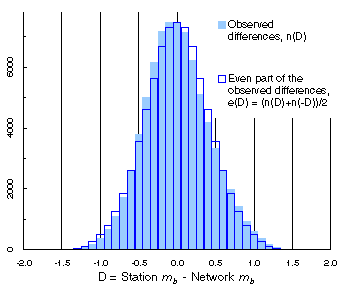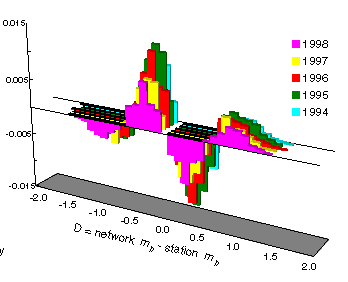Are we correcting a censoring effect?
|
Seismologists have long recognized that magnitudes can be biased as a result of small amplitude signals falling below background noise levels. Systematically excluding small amplitudes, say those of arrivals near nodal planes, results in larger magnitudes an unbiased estimate. The recent proliferation of arrays and low-noise stations may make it possible to measure amplitude of near-nodal signals that were more often missed in the past. If so, then ISC mb values would decline as the result of correcting a previous positive bias. |
|
|
Censoring is revealed in skewness of the differences between magnitudes from individual stations and the network average for each earthquake. It is easy to see skewness of ISC 1995 station magnitudes. Far from the the network average, there is a lack of small station mb values, probably the direct result of censoring. There is an excess of smaller station mb values. This would result from a positive bias of the network average. |

|
|
Skewness of station mb is decreasing:
Year Skew*
1994 5.0%
1995 6.5%
1996 5.4%
1997 4.0%
1998 3.5%
This supports the idea that a decrease in censoring affecting mb, but the changes seem too small to explain the observed rate changes. * Skew := integral of |n(D)-n(-D)| / 2 divided by integral of n(D). |

|
It's not all down to censoringChanges in station magnitude skewness are too small to explain the large apparent shifts of mb. |
|

